Hst 1100 Study guides, Class notes & Summaries
Looking for the best study guides, study notes and summaries about Hst 1100? On this page you'll find 26 study documents about Hst 1100.
All 26 results
Sort by
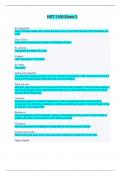
-
HST 1100 Exam 2 - Questions and Answers
- Exam (elaborations) • 7 pages • 2023
-
- $15.49
- + learn more
HST 1100 Exam 2 - Questions and Answers St. Augustine Early Christian leader who writes the book City of God that instructs how Christians are to be City of God Augustine's book about the fall of the Roman Empire St. Jerome Translated the Bible into Latin Vulgate Latin translation of the Bible St. Peter First pope Goths and Visigoths The Germanic tribes that took over the Roman Empire when it fell, Visigoths were just a branch of the Germanic tribes that took over the empire. Attila the Hun 40...
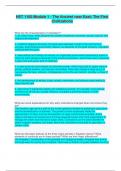
-
HST 1100 Module 1 - The Ancient near East: The First Civilizations
- Exam (elaborations) • 5 pages • 2023
-
Available in package deal
-
- $10.49
- + learn more
HST 1100 Module 1 - The Ancient near East: The First Civilizations What are the characteristics of civilization? 1. an urban focus: cities became the centers of political, economic, social, cultural, and religious development; 2. a distinct religious structure: the gods were deemed crucial to the community's success, and professional priestly classes, as stewards of the gods' property, regulated relations with the gods; 3. new political and military structures: an organized government bureauc...
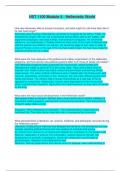
-
HST 1100 Module 4 - Hellenistic World
- Exam (elaborations) • 4 pages • 2023
-
Available in package deal
-
- $10.99
- + learn more
HST 1100 Module 4 - Hellenistic World How was Alexander able to amass his empire, and what might his rule have been like if he had lived longer? Alexander was the king of Macedonia, groomed for kingship by his father, Phillip. He amassed his empire with the use of advanced tactical skills used to win battles, well organized campaigns, merciless killings, and extensive conquests. He smothered rebellions, one specifically in Thebes where he killed most of the male inhabitants and sold the women a...
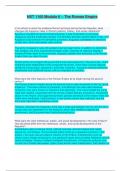
-
HST 1100 Module 6 – The Roman Empire
- Exam (elaborations) • 4 pages • 2023
-
Available in package deal
-
- $10.99
- + learn more
HST 1100 Module 6 – The Roman Empire In his efforts to solve the problems Rome had faced during the late Republic, what changes did Augustus make in Rome's political, military, and social institutions? Augustus changed the governmental structure, it was comprised of a princeps (Augustus) and the aristocratic senate. The Senate's decrees had the effect of law, and Augustus could overrule the senatorial governors. Augustus' candidates for elections usually won, which decreased voter turnout....
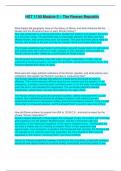
-
HST 1100 Module 5 – The Roman Republic
- Exam (elaborations) • 4 pages • 2023
-
Available in package deal
-
- $10.49
- + learn more
HST 1100 Module 5 – The Roman Republic What impact did geography have on the history of Rome, and what influence did the Greeks and the Etruscans have on early Roman history? Italy was positioned on a narrow peninsula, divided into eastern and western territories by a mountain range. The peninsula was a crossroads between the West and East Mediterranean, and communities were not isolated. The land had fertile plains ideal for farming, and access to the sea, but was far enough inland to be eas...
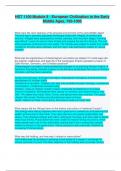
-
HST 1100 Module 8 - European Civilization in the Early Middle Ages, 750-1000
- Exam (elaborations) • 5 pages • 2023
-
Available in package deal
-
- $11.49
- + learn more
HST 1100 Module 8 - European Civilization in the Early Middle Ages, 750-1000 What were the main features of the physical environment of the early Middle Ages? The land was a sparsely populated landscape dotted with villages of farmers and warriors. Villages were separated by forests, swamps, and mountain ridges. Farming was difficult, it was not easy to clear forests and prepare the land for farming. The soil, when prepared, produced very low yields. The climate was subject to wetter and colder...
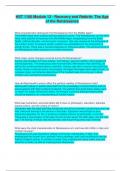
-
HST 1100 Module 12 - Recovery and Rebirth: The Age of the Renaissance
- Exam (elaborations) • 4 pages • 2023
-
Available in package deal
-
- $10.49
- + learn more
HST 1100 Module 12 - Recovery and Rebirth: The Age of the Renaissance What characteristics distinguish the Renaissance from the Middle Ages? The Middle Ages were a period lacking classical culture. The Renaissance, on the other hand, was a period of recovery from the Middle Ages, recuperating from the Black Death, political disorder, and economic recession. Italy was viewed as the birthplace of the modern world. Increasing wealth created new possibilities for the enjoyment of worldly things. Th...
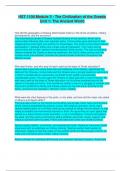
-
HST 1100 Module 3 - The Civilization of the Greeks Unit 1: The Ancient World
- Exam (elaborations) • 4 pages • 2023
-
Available in package deal
-
- $10.49
- + learn more
HST 1100 Module 3 - The Civilization of the Greeks Unit 1: The Ancient World How did the geography of Greece affect Greek history in the terms of politics, military developments, and the economy? The mountainous terrain of Greece isolated Greeks of one another, which led to communities following their own separate paths. Communities grew attached to their independence and fought one another for advantages. The small communities fostered participation in political affairs and unique cultural ex...
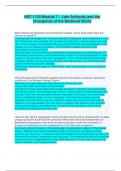
-
HST 1100 Module 7 – Late Antiquity and the Emergence of the Medieval World
- Exam (elaborations) • 4 pages • 2023
-
Available in package deal
-
- $11.49
- + learn more
HST 1100 Module 7 – Late Antiquity and the Emergence of the Medieval World What reforms did Diocletian and Constantine institute, and to what extent were the reforms successful? Diocletian split the empire into 100 provinces and 12 dioceses, each headed by a vicar. The 12 dioceses were grouped into 4 prefectures (tetrarchy), and the empire was split into 2: east and west. He instituted the policy that all Romans should participate in the imperial cult, worshiping the emperor. The Christians r...
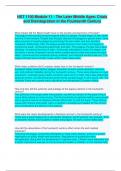
-
HST 1100 Module 11 - The Later Middle Ages: Crisis and Disintegration in the Fourteenth Century
- Exam (elaborations) • 4 pages • 2023
-
Available in package deal
-
- $10.99
- + learn more
HST 1100 Module 11 - The Later Middle Ages: Crisis and Disintegration in the Fourteenth Century What impact did the Black Death have on the society and economy of Europe? The plague had a profound psychological effect on people. People began to fear death and live in the moment. People also thought God sent the plague to punish them. Jews were accused of causing plague by poisoning the town wells, and anti-semitism increased. Additionally, after the plague people became more violent and began t...

Study stress? For sellers on Stuvia, these are actually golden times. KA-CHING! Earn from your study resources too and start uploading now. Discover all about earning on Stuvia


